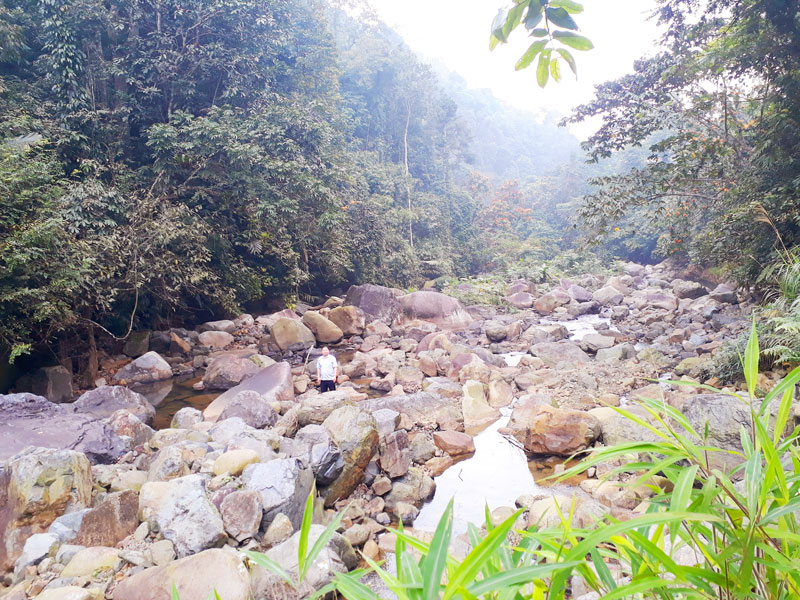
(HBO) - Covering more than 6,000 ha, Thuong Tien Nature Reserve spreads across the three communes of Kim Tien, Thuong Tien (Kim Boi district), and Quy Hoa (Lac Son district). Thuong Tien commune lies in a core zone of more than 5,000 ha. Khu hamlet, inhabited by the Muong ethnic group, has the largest wild forested area in the province.

Thuong Tien Nature Reserve with Khu stream.
The distance from the
headquarters of the People’s Committee of Thuong Tien commune to Khu hamlet is
over 5 km. After half an hour of travel, the hamlet appears amongst the green
terraced fields. From Khu hamlet, we started our journey exploring Thuong Tien Nature
Reserve. Lined along both sides of the road are majestic, old trees – most of which
would take two or three people to wrap their arms around the base.
An hour later, we were about 2 km deep into the
forest and found a large rocky area with huge stones. This was the Khu stream. It
is interesting to note that many parts of the area have quite flat sand banks,
suitable for camping or putting up a tent to stay overnight. There are also
some sections of the stream blocked by large stones, creating deep rock pools
which are dozens of square metres wide. Local people have come to describe them
as natural pools in the forest.
Despite her exhaustion, Bui Kim Thanh from Ha Bi commune (Kim Boi) said she was
very impressed with this experience.She said: "This is the first time I’ve been
to the Thuong Tien Nature Reserve. I am impressed by its stunning scenery with
a beautiful stream in the middle of the primeval forest. Once it receives proper
investment, the reserve will undoubtedly become an attractive tourism spot.”
We
stopped at a flat rocky area near Khu stream, with ancient trees lining the two
banks. The water is so clear that the riverbed can be seen from above. We had the
chance to enjoy grilled fish, grilled chicken, and some jungle-grown vegetables.
We did not need to bring along chopsticks, spoons, or cups for drinking wine
with as these were all sourced by finding nature’s crockery solutions in the
forest.
We had a talk with some of the local residents who expressed their hope that
the reserve will soon become a tourism site, helping to alleviate poverty in
the area.
Bui
Thi Hai, Secretary of the Thuong Tien commune youth union said: "Many people
have visited and explored the primitive
and stunning beauty of the Thuong Tien Nature Reserve. People living in the
commune have faced a range of difficulties as they completely rely on
agriculture with low earnings. Therefore, tourism development would help them
raise their incomes and living standards.”
The
Hoa Binh provincial People’s Committee aims to develop tourism at the Thuong
Tien Nature Reserve. Currently, the commune is making efforts to restore and
develop local specialties, preserve and promote the traditional culture of the
Muong ethnic group, and continue to coordinate with the management board of the
reserve to improve works in forest protection.
Nguyen
Ngoc Thuy, Chairwoman of the People’s Committee of Thuong Tien commune said: "The
provincial People’s Committee has plans to develop tourism at the reserve.
Thuong Tien commune is working hard to restore and develop local specialties,
preserve and promote traditional culture of Muong people, and better forest
protection works.”
A diverse chain of eco-tourism and resort destinations concentrated in Hoa Binh city and the districts of Tan Lac, Da Bac, and Luong Son… Along with the launch of several key high-quality resort tourism projects, these developments have reshaped the landscape and enhanced the appeal of Hoa Binh as a travel destination.
Boasting diverse terrain, a mild climate, and rich natural resources, Cao Phong district is increasingly asserting its place on Vietnam’s tourism map, attracting both domestic and foreign visitors. The district is renowned for its stunning landscapes, majestic mountains, a crystal-clear hydropower lake, and the unique cultural identity of local ethnic groups.
With its pristine landscapes, unique cultural heritage of Muong ethnic minority, and an expanding range of visitor experiences, Tan Lac district of Hoa Binh has fast become a captivating destination for both domestic and international tourists.
Until now, Sung village in Cao Son commune, Da Bac district remains the only Dao ethnic community in Hoa Binh province to develop a community-based tourism model. Beyond its untouched natural landscapes, cultural identity serves as the cornerstone attraction for visitors.
Alongside the diverse cultural identities of the Kinh, Muong, Tay, Thai, Dao, and Mong ethnic people, Hoa Binh province is also renowned as the "capital" of the northwestern Vietnamese cuisine, offering unique and distinctive dishes. At festivals, during Lunar New Year (Tet), or on significant family or community occasions, special dishes are prepared, leaving a lasting impression on visitors.
A Phong Linh (Yellow Tabebuia) flower garden in Thang village, Thach Yen commune, Cao Phong district is currently in full bloom, drawing a large number of visitors.



